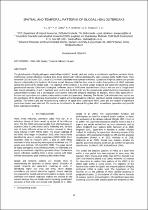JavaScript is disabled for your browser. Some features of this site may not work without it.
- ResearchSpace
- →
- Research Publications/Outputs
- →
- Conference Publications
- →
- View Item
| dc.contributor.author |
Si, YL

|
|
| dc.contributor.author |
Debba, Pravesh

|
|
| dc.contributor.author |
Skidmore, AK

|
|
| dc.contributor.author |
Toxopeus, AG

|
|
| dc.contributor.author |
Li, L

|
|
| dc.date.accessioned | 2008-12-17T07:19:44Z | |
| dc.date.available | 2008-12-17T07:19:44Z | |
| dc.date.issued | 2008-07 | |
| dc.identifier.citation | Si, Y, Debba, P, Skidmore, AK, Toxopeus, AG, Li, L. 2008. Spatial and temporal patterns of global H5N1 outbreaks. The International Archives of the Photogrammetry, Remote Sensing and Spatial Information Sciences. Vol. XXXVII, pp 69-74 | en |
| dc.identifier.issn | 1682-1750 | |
| dc.identifier.uri | http://hdl.handle.net/10204/2758 | |
| dc.description | Paper presented at the 21st Congress of the International Society for Photogrammetry and Remote Sensing (ISPRS): 3-11 July 2008 "Silk road for information from imagery," Beijing, China | en |
| dc.description.abstract | The global spread of highly pathogenic avian influenza (H5N1) in wild birds and poultry is considered a significant pandemic threat. Furthermore, human infections resulting from direct contact with infected birds/ poultry pose a serious public health threat. From November 2003 to March 2007, a total of 3345 H5N1 outbreaks were reported worldwide. Spatial and temporal patterns can provide clues in understanding the dynamics of disease spread. However, little has been done to explore these patterns of H5N1 outbreaks during this period at the global scale. The objective of this research is to detect spatial, temporal and space-time clustering using geostatistical methods. Data from histological confirmed cases of H5N1 were obtained from a Dutch web site and a Google earth data. Kernel estimation, G and F functions were used to test the first-order and the second-order spatial clustering respectively. An autocorrelation function and a periodogram were used to detect the temporal clustering. In addition, Knox's test, space-time K-function and space-time scan statistics were used to explore the space-time clustering. The Monte Carlo simulation was used to test the significance of the clustering and seasonal cyclicity. The Monte Carlo test revealed strong evidence for space-time clustering of H5N1 cases and the location of significant space-time clusters were detected. The results are considered to be valuable for glabal H5N1 surveillance, prevention and possible future outbreaks controlling. | en |
| dc.language.iso | en | en |
| dc.publisher | International Society for Photogrammetry and Remote Sensing | en |
| dc.subject | H5N1 | en |
| dc.subject | GIS | en |
| dc.subject | Spatial | en |
| dc.subject | Temporal | en |
| dc.subject | Global | en |
| dc.subject | Hot spots | en |
| dc.title | Spatial and temporal patterns of global H5N1 outbreaks | en |
| dc.type | Conference Presentation | en |
| dc.identifier.apacitation | Si, Y., Debba, P., Skidmore, A., Toxopeus, A., & Li, L. (2008). Spatial and temporal patterns of global H5N1 outbreaks. International Society for Photogrammetry and Remote Sensing. http://hdl.handle.net/10204/2758 | en_ZA |
| dc.identifier.chicagocitation | Si, YL, Pravesh Debba, AK Skidmore, AG Toxopeus, and L Li. "Spatial and temporal patterns of global H5N1 outbreaks." (2008): http://hdl.handle.net/10204/2758 | en_ZA |
| dc.identifier.vancouvercitation | Si Y, Debba P, Skidmore A, Toxopeus A, Li L, Spatial and temporal patterns of global H5N1 outbreaks; International Society for Photogrammetry and Remote Sensing; 2008. http://hdl.handle.net/10204/2758 . | en_ZA |
| dc.identifier.ris | TY - Conference Presentation AU - Si, YL AU - Debba, Pravesh AU - Skidmore, AK AU - Toxopeus, AG AU - Li, L AB - The global spread of highly pathogenic avian influenza (H5N1) in wild birds and poultry is considered a significant pandemic threat. Furthermore, human infections resulting from direct contact with infected birds/ poultry pose a serious public health threat. From November 2003 to March 2007, a total of 3345 H5N1 outbreaks were reported worldwide. Spatial and temporal patterns can provide clues in understanding the dynamics of disease spread. However, little has been done to explore these patterns of H5N1 outbreaks during this period at the global scale. The objective of this research is to detect spatial, temporal and space-time clustering using geostatistical methods. Data from histological confirmed cases of H5N1 were obtained from a Dutch web site and a Google earth data. Kernel estimation, G and F functions were used to test the first-order and the second-order spatial clustering respectively. An autocorrelation function and a periodogram were used to detect the temporal clustering. In addition, Knox's test, space-time K-function and space-time scan statistics were used to explore the space-time clustering. The Monte Carlo simulation was used to test the significance of the clustering and seasonal cyclicity. The Monte Carlo test revealed strong evidence for space-time clustering of H5N1 cases and the location of significant space-time clusters were detected. The results are considered to be valuable for glabal H5N1 surveillance, prevention and possible future outbreaks controlling. DA - 2008-07 DB - ResearchSpace DP - CSIR KW - H5N1 KW - GIS KW - Spatial KW - Temporal KW - Global KW - Hot spots LK - https://researchspace.csir.co.za PY - 2008 SM - 1682-1750 T1 - Spatial and temporal patterns of global H5N1 outbreaks TI - Spatial and temporal patterns of global H5N1 outbreaks UR - http://hdl.handle.net/10204/2758 ER - | en_ZA |






